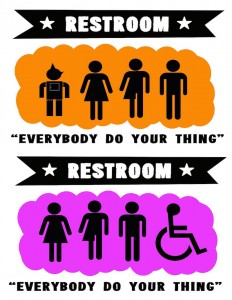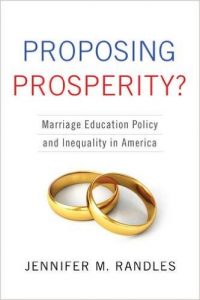 Katherine Gallagher Robbins is a Director of Family Policy at the Center for American Progress. She focuses her work on economic security, family policy, women’s issues, and poverty. She has had years of experience in these types of research, as she also served as the director of research and policy analysis at the National Women’s Law Center before joining the Center for American Progress. Her work is cited on many media outlets, and she has authored many reports and analyses. More recently, she coauthored a brief titled: “4 Progressive Policies that Make Families Stronger” with Shawn Fremstad. Read the whole thing—and read a short review of it here on The Society Pages.
Katherine Gallagher Robbins is a Director of Family Policy at the Center for American Progress. She focuses her work on economic security, family policy, women’s issues, and poverty. She has had years of experience in these types of research, as she also served as the director of research and policy analysis at the National Women’s Law Center before joining the Center for American Progress. Her work is cited on many media outlets, and she has authored many reports and analyses. More recently, she coauthored a brief titled: “4 Progressive Policies that Make Families Stronger” with Shawn Fremstad. Read the whole thing—and read a short review of it here on The Society Pages.
Shawn Fremstad is a Senior Fellow at the Center for American Progress and a senior research associate at the Center for Economic and Policy Research. Like Gallagher Robins, he focuses his research on economic security, family policy, and poverty. Before working for the Center for American Progress he was a deputy director of welfare reform and income support at the Center of the Bridging the Gaps project at the Center for Economic and Policy Research, and before that worked as a legal service attorney.
After reading their 4 Progressive Policies brief, I had questions about their ideas in the new political climate, and Robbins and Shawn Fremstad gave me some sobering answers.
Q: You make it seem so clear that progressive policy agendas offer more support for family stability, so how do you believe families will be impacted now that we have a conservative president-elect who, so far, has selected a team of very conservative individuals to work with him?
A: For a long time, the received wisdom was that conservative policies promote “family values” and liberal ones undermine them. But a growing body of research shows this just isn’t the case. Naomi Cahn and June Carbone, for example, have highlighted how the “blue family model”—which emphasizes birth control, higher education, and egalitarian relationship norms—has contributed to lower divorce rates, higher ages at first birth, and greater economic security. Similarly, our work shows that states with progressive, pro-worker policy agendas – that have raised their minimum wage, rejected laws that deter unions, and expanded access to health care, including reproductive care – are also places where families tend to have better outcomes. That’s likely due in part to the fact that such policies promote economic security, better health outcomes, less work-life conflict, and other factors positively associated with family stability and health for a wide range of family types.
Given this research, one of our key concerns is that the President-elect and a Congress controlled by conservatives will undermine or repeal important policies that stabilize and support families, particularly working-class and poor families. One of the big success stories of the last decade or so has been the extent to which programs like Medicaid, SNAP (formerly food stamps) and the EITC have become more inclusive and accessible to working class families, including many married and partnered ones. A related success story is the expansion of access to reproductive health care and comprehensive sex education programs, which have contributed to the substantial reductions in the birth rate among women under age 25.
The most immediate threat right now is the President-elect’s commitment to repeal the successful Affordable Care Act. This is effectively a pledge to take away health insurance coverage from 30 million Americans, most of whom are working class, and reduce access to the kind of effective reproductive care that has been a central part of the blue family model. Similarly, Trump’s tax proposal would raise taxes on nearly 8 million families with children—the vast majority of them are families headed by single and other unmarried parents.
These kinds of policies are best understood as part of a larger, right-wing effort to restore a Mad Men-era policy regime in which only the “right” kinds of families are valued and supported.
Q: What are you going to do now? I know you can’t tell us your whole year’s plan, but what are some of the top issues or top approaches?
A: Our first priority is blocking proposals by the President-elect and Congressional leaders that would take away health insurance, nutrition assistance, and other important benefits from tens of millions of struggling working-class families. Another priority is defending immigrant families from mass deportation. President Obama’s Deferred Action for Child Arrivals, or DACA, initiative, has improved the lives of hundreds of thousands of families, but the President-elect has threatened to end it and deport these families.
At the same time, there may be some limited opportunities to get a better deal for working- and middle-class families when it comes to federal policy, such as child care and paid family leave. The President-elect has said he will work with Congress to pass an affordable child care and elder care bill during his first 100 days in office. But as currently drafted, his plan will mostly help rich families, and do little for working class ones.
On paid family leave, Senator Marco Rubio has proposed a modest paid parental-leave program and the President-elect has proposed a program that is limited to new mothers. Both plans fall far short of the kind of plan that caregivers deserve—a social insurance program that provides paid leave in an inclusive fashion and promotes egalitarian caregiving norms. But if the President-elect follows through on his promise to establish a paid maternal leave program, and puts something workable on the table, then we will likely work to make sure it isn’t just limited to mothers, and is as inclusive and effective as possible.
Additionally, we are thinking about how and where we can expand our work at the state and local levels to support families there. Many states and localities have stepped up in recent years and passed a number of proposals that have been critical to families. For example, in the last half of 2016 alone state and local wins provided nearly seven million workers with access to paid sick time with an inclusive family definition that works for every family. We will be working to grow this number in the coming months and years.
The city council where we both live, Washington, D.C., just voted to approve a paid leave program that’s likely to become law, joining California, Rhode Island, New Jersey, New York, and a number of cities and localities. Similarly, there has been a lot of momentum on increasing state minimum wages over the past several years; just last month, voters in four very different states—Arizona, Colorado, Maine, and Washington—approved minimum wage increases.
Q: How do you see this election affecting your own families? OR What are some abiding beliefs about research and policy work on families that will help you through this surprising new era?
Kate: I’m deeply concerned about so many people in my family. I worried for the health and safety of my LGBTQ family members – both those I’m related to by legal ties and those I’m related to by choice. I’m worried about the economic security and health of my sister-in-law, who is a person with severe developmental disabilities and for whom there are already too few supports. I’m anxious about the prejudice that my family members of color and those who are immigrants are more likely to face as we enter an era of rising hate speech and hate crimes. I’m worried about the fates of my family members who are serving in our nation’s military. That’s why it’s so critical that we work hard to ensure families are protected and supported.
Shawn: I’m a part-time worker on an annual contract and purchase my health insurance through DC’s ACA exchange. I’m also an unmarried, single parent who files as a head of household. So I’m looking at a tax increase and paying even more for health care. But much more importantly, I’m worried about the impact of this election on my nine-year old son. He was even more upset by the outcome than I was. Pretty much every day since the election he asks me: “What horrible thing did Trump do today?” Before the election, I was hopeful that by the time he graduated from high school, things like millions of Americans going without health coverage would be a thing of the past, and policies that promote egalitarian caregiving, like paid family leave, would be the new normal. I still want to believe this is possible, but it is going to take a lot of hard work and progressive solidarity in the coming months and years.
Molly McNulty is a CCF Public Affairs intern at Framingham State University. She is a senior Sociology and Education major.










 If you are interested in families, the most recent presidential election brings a trail of troubles. A lot of Americans fear what is in store in the near future and are anxious about the clear division in popular attitudes that now exists in what is supposed to be the United States. Family policy will be deeply impacted as a result of this division. For direction, Kate Gallagher Robbins and Shawn Fremstad offer a light in the darkness in a recent brief—using evidence to clarify uncertainty.
If you are interested in families, the most recent presidential election brings a trail of troubles. A lot of Americans fear what is in store in the near future and are anxious about the clear division in popular attitudes that now exists in what is supposed to be the United States. Family policy will be deeply impacted as a result of this division. For direction, Kate Gallagher Robbins and Shawn Fremstad offer a light in the darkness in a recent brief—using evidence to clarify uncertainty.  I attended my first healthy marriage education class with Christine and Bill, a white middle-class married couple studying to become marriage educators for their church. The first relationship skill we learned during our
I attended my first healthy marriage education class with Christine and Bill, a white middle-class married couple studying to become marriage educators for their church. The first relationship skill we learned during our